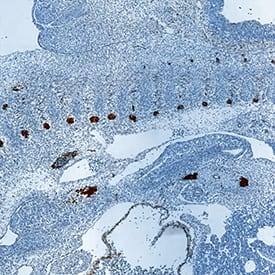Human/Mouse GDF-11/BMP-11 Antibody
R&D Systems, part of Bio-Techne | Catalog # AF1958

Key Product Details
Species Reactivity
Validated:
Human, Mouse
Cited:
Rat
Applications
Validated:
Immunohistochemistry
Cited:
Western Blot
Label
Unconjugated
Antibody Source
Polyclonal Goat IgG
Product Specifications
Immunogen
E. coli-derived recombinant human GDF‑11/BMP‑11
Asn299-Ser407
Accession # O95390
Asn299-Ser407
Accession # O95390
Specificity
Detects human and mouse GDF‑11/BMP‑11 in direct ELISAs and Western blots. In direct ELISAs, no cross-reactivity with recombinant human/mouse/rat GDF-8/Myostatin and less than 1% cross-reactivity with recombinant human BMP-6 is observed.
Clonality
Polyclonal
Host
Goat
Isotype
IgG
Scientific Data Images for Human/Mouse GDF-11/BMP-11 Antibody
GDF‑11/BMP‑11 in Mouse Embryo.
GDF‑11/BMP‑11 was detected in immersion fixed frozen sections of mouse embryo (11 d.p.c.) using Goat Anti-Human/Mouse GDF‑11/BMP‑11 Antigen Affinity-purified Polyclonal Antibody (Catalog # AF1958) at 15 µg/mL overnight at 4 °C. Tissue was stained using the Anti-Goat HRP-DAB Cell & Tissue Staining Kit (brown; Catalog # CTS008) and counterstained with hematoxylin (blue). Specific staining was localized to dorsal root ganglia. View our protocol for Chromogenic IHC Staining of Frozen Tissue Sections.Applications for Human/Mouse GDF-11/BMP-11 Antibody
Application
Recommended Usage
Immunohistochemistry
5-15 µg/mL
Sample: Immersion fixed frozen sections of mouse embryo (11 d.p.c.)
Sample: Immersion fixed frozen sections of mouse embryo (11 d.p.c.)
Formulation, Preparation, and Storage
Purification
Antigen Affinity-purified
Reconstitution
Reconstitute at 0.2 mg/mL in sterile PBS. For liquid material, refer to CoA for concentration.
Formulation
Lyophilized from a 0.2 μm filtered solution in PBS with Trehalose. *Small pack size (SP) is supplied either lyophilized or as a 0.2 µm filtered solution in PBS.
Shipping
Lyophilized product is shipped at ambient temperature. Liquid small pack size (-SP) is shipped with polar packs. Upon receipt, store immediately at the temperature recommended below.
Stability & Storage
Use a manual defrost freezer and avoid repeated freeze-thaw cycles.
- 12 months from date of receipt, -20 to -70 °C as supplied.
- 1 month, 2 to 8 °C under sterile conditions after reconstitution.
- 6 months, -20 to -70 °C under sterile conditions after reconstitution.
Background: GDF-11/BMP-11
References
- Gamer, L.W. et al. (1999) Dev. Biol. 208: 222.
- Nakashima, M. et al. (1999) Mech. Dev. 80:185.
- Gad, J.M. and P.P.L. Tam (1999) Curr. Biol. 9:R783.
- McPherron, A.C. et al. (1999) Nat. Genet. 22:260.
- Esquela, A.F. and S.J. Lee (2003) Dev. Biol. 257:356.
- Gamer, L.W. et al. (2001) Dev. Biol. 229:407.
- Oh, S.P. et al. (2002) Genes & Dev. 16:274.
Long Name
Growth Differentiation Factor 11
Alternate Names
BMP-11, BMP11, GDF11
Entrez Gene IDs
10220 (Human)
Gene Symbol
GDF11
UniProt
Additional GDF-11/BMP-11 Products
Product Documents for Human/Mouse GDF-11/BMP-11 Antibody
Product Specific Notices for Human/Mouse GDF-11/BMP-11 Antibody
For research use only
